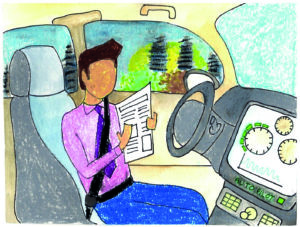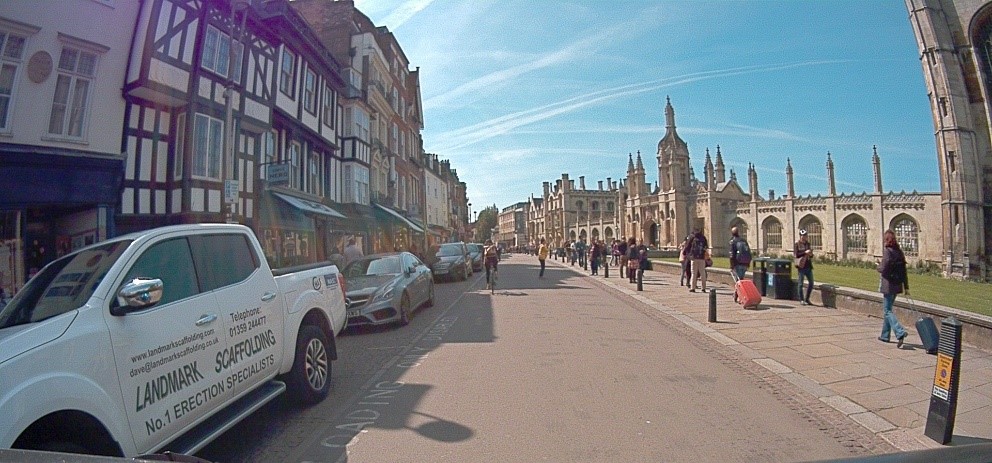SUNDAY, 4 AUGUST 2019
In the UK, there are 48 million driving license holders, around three-quarters of the population. The car has been a huge enabler of personal mobility across society and the ability to travel is a large part of the quality of life we now enjoy. But for such an embedded part of our culture there are many negative effects of driving, for instance, the average worker spends 54 minutes of their day commuting and in 2015 there were nearly 200,000 casualties due to road accidents. It is no surprise then, that the field of driverless cars – or autonomous vehicles, which drive using computer systems with artificial intelligence (AI) built in - has attracted research and investment on a global scale. The advent of self-driving cars could reduce road fatalities by a factor of 10 and cause the most disruptive technological change in transport since horses were outpaced by internal combustion engines. However, there are substantial risks to the development of the technology such as stifling regulation and potential downsides such as job losses.
What would you say to others with ideas to start a business in technology?
This article route-checks the path to mainstream adoption of autonomous vehicles, explores some of the challenges on the way and looks at how they could be overcome to benefit society and enable environmentally efficient mobility. BlueSci speaks to Professor John Miles whose research into Transitional Energy Strategies at the University of Cambridge explores the potential to reduce urban emissions through radical alternatives to conventional transport systems. BlueSci also interviews Amar Shah, founder and CEO of Wayve, a Cambridge start-up that develops and tests machine learning algorithms for autonomous vehicles.
John Miles, Professor of Transitional Energy Strategies at the University of Cambridge
Why is autonomous transport an important topic for research?
“There is a dim view of transport currently, the politically correct view is that it’s not sustainable to travel and that we should travel less. However, mobility is a fundamental part of the quality of life we all enjoy, therefore we should get rid of the side effects of transport. Electric vehicles and autonomous vehicles have the ability to ameliorate these bad side effects. It is obvious that electric vehicles stand to reduce emissions, noise and other unpleasant side effects. Autonomous vehicles offer additional benefits such as more efficient fuel consumption, reduced congestion and increased safety.”
A lot of people in the UK are employed as professional drivers or in taxi companies. Does this make the emerging technology a threat or an opportunity?
“I think superficially it’s a threat because of the very large number of drivers. For example, in Milton Keynes there are around 1400 taxi drivers representing a big local employer. If you made all these vehicles autonomous you’d suddenly put 1400 people out of business overnight. If you multiply that up across all the cities in the UK you end up with a very large number of people. The counterargument is that if autonomous vehicles became ubiquitous because they were cheap and flexible, everyone currently using their own cars would start to use taxis as well. With this demand the ridership of these vehicles would shoot up and the associated duties of maintaining that fleet would create new jobs. In an ideal world, the people displaced from being drivers might be employed as mechanics, service clerks and centre answerers. There’d just be different jobs. Whether that’s true or not remains to be seen… But there will be jobs created by this transition.”
According to Bill Gates, although the technology underpinning autonomous driving is good, the actual adoption will be slower due to the slow rate of regulation and policy making. Do you think the transition will be incremental or would you expect a more sweeping change?
“I think social acceptance of new technology is very much based on the perception of utility. I think the time between making the technology available and widespread public uptake will be relatively short. To qualify, I don’t think fully autonomous vehicles will be available any time soon; perhaps 2040-2050. But we should see limited autonomy fairly soon. At the moment even with automated lane change you’re still the driver in the hot seat – but once you can turn your brain off and read a newspaper driving three hours down the M1 everyone is going to want to do it.”
The potential transformative effects described by Professor Miles have created a race to develop both the hardware and the software underpinning these future autonomous vehicles.
Amar Shah, founder and CEO of start-up Wayve
What does Wayve do?
“We are aiming to build the AI brain of autonomous vehicles, all the way from sensing the world with cameras to decision-making on steering, accelerating and braking. Many of the people working on the technology have good algorithms but can’t gain the last few percentage points of accuracy to have sufficient safety and confidence. We are using an end-to-end approach, which means directly optimising the entire pipeline in one algorithm. Many of the established companies use a modular approach, which separates the problem into multiple blocks and then stitches together the solutions in each block. Although the modular approach makes the algorithm interpretable there are problems with errors that can propagate into the end decision. We think end-to-end training is a potential way around this, which means focusing on our end goal and training our entire model to fit the end goal.”


“If you look at some of the early self-driving cars they often looked like tanks with all sorts of sensors and spinning things. For example, it’s common to have a sedan with 12 LIDAR (light detection and ranging) sensors and 12 cameras. Then different teams take these inputs and try to fuse them together to make a single cohesive representation of what’s going on and then try to decide thereafter what to do with these modules. This creates redundancy and you spend a lot of human and computational resources collating all this information and figuring out what to do with it. We think our approach - which is lean on both the hardware and software side - allows us to simplify the machine learning part of the problem, as well as testing and modelling. Our recent demonstration in June had a model with a very small neural network, only 10,000 parameters. For context, today’s top image classification models have tens of millions of parameters. This car was able to learn to follow lanes in 15-20 minutes, so we think we can do a lot with very specialised small models.”
How can a startup fit into a landscape dominated by huge tech firms who are investing billions into the technology?
“I don’t think anyone has a very clear idea of what the business models will look like. I certainly think there will be partnerships and collaboration between companies who are good at making cars and others who are good at making intelligent algorithms. One way we could enter the market is by partnering with a fleet provider who leases us cars that we program with our algorithm and operate as an autonomous fleet. Alternatively, a company like ours could simply license algorithms to automakers who are less specialized in creating intelligent algorithms.”
“I think you need to have a vision and really test it by looking at what’s around and why you want to build this company. I think building up experience and credentials in the tech world also helps to convince potential stakeholders. I hope more people from Cambridge do stuff like this because we have great talent here and investment in the UK tech scene has really risen over the last five years. But I think really believing in your vision and your ability to execute is key.”
James Macdonald is a PhD student in the Department of Engineering at Darwin College.
